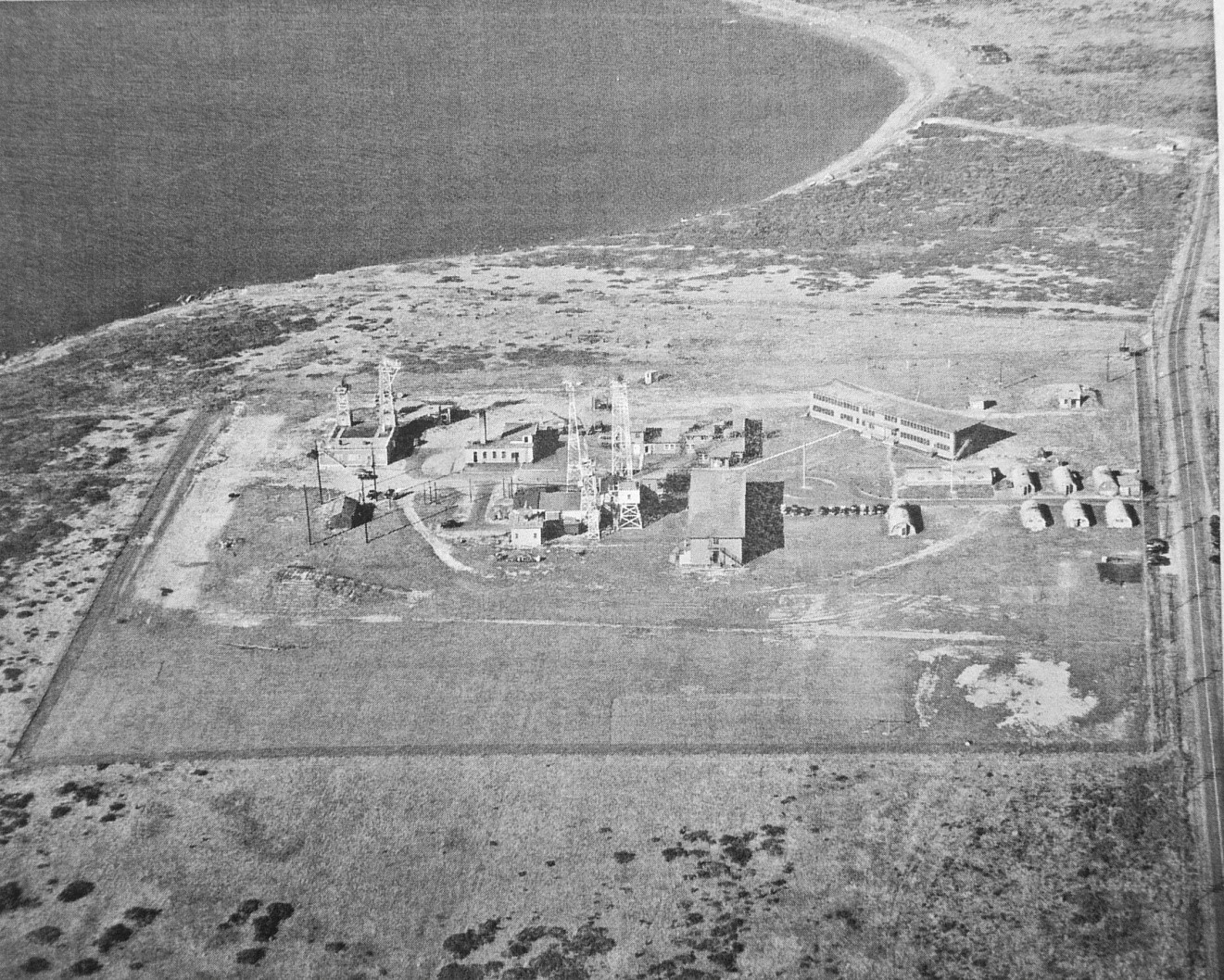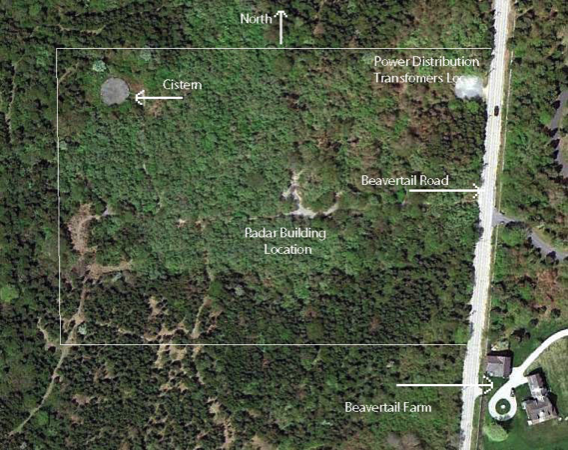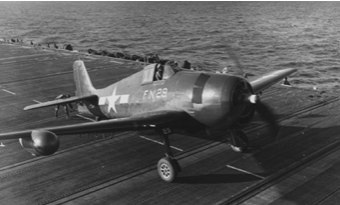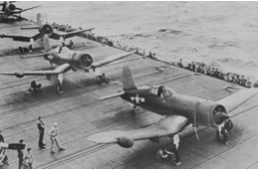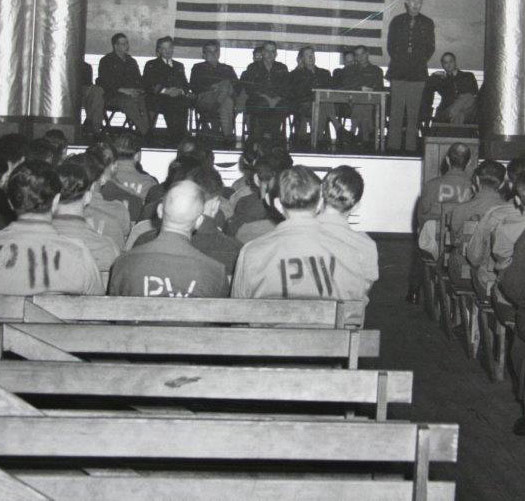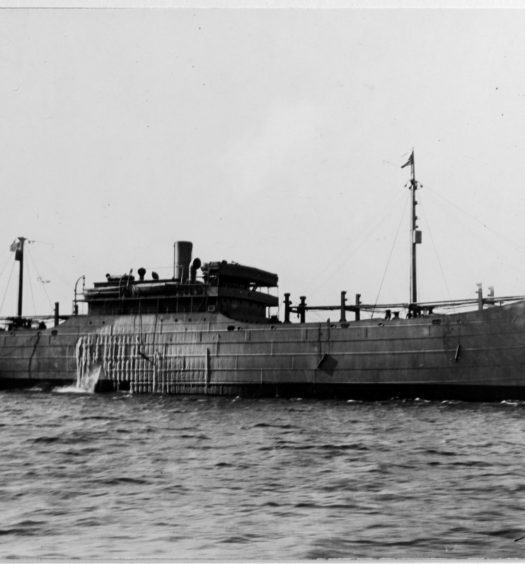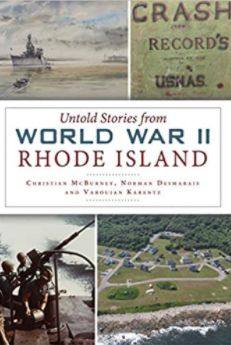Spraycliff Observatory, located on the Beavertail peninsula on Conanicut Island (the town of Jamestown), was a top secret World War II facility. The activities of Spraycliff Observatory provided a crucial contribution to the U.S. Navy and its Pacific theater operations during World War II.
During World War II, little was known of the highly confidential activities at Spraycliff. Even today information on it is scarce. Although I conducted a number of searches of various government archives, I uncovered comparatively few related documents. I gained some information from interviews and exchanges of correspondence with actual personnel assigned to the site, but many readily admitted that their recollections of events that occurred almost seventy-five years ago were somewhat vague. Accordingly, this article cannot tell the whole story.
After the Japanese attack on Pearl Harbor on December 7, 1941, the military might of U.S. was initially directed against Nazi Germany in Europe. Still, U.S. military forces eventually made the Pacific theatre an active one. The first U.S. amphibious landings did not take place until August 1942 on Tulagi and Guadalcanal in the Solomon Islands, and in June 1943 on New Guinea and New Georgia.
The Japan military’s response to these early losses focused on retaliatory attacks by its ground-based bombers, many occurring at night. Successful low-level nighttime attacks on American ground units and ships by Japanese light and heavy bombers escorted by fighter aircraft jolted the U.S Navy to design, equip, and train squadrons of night fighter interceptor aircraft. By 1944 and 1945, realizing that it was losing the war, Japan launched a terrifying campaign of Kamikaze aircraft against U.S. Navy aircraft carriers and other capital warships. Many of these suicide attacks also occurred at night, further emphasizing the need for the U.S. Navy’s aircraft to excel at night fighting.
Back in Rhode Island, beginning in 1941 and for the next thirty-three years, the Beavertail peninsula from just north of Beavertail Farm and south to Beavertail Light Station was closed to the general public and devoted to the war effort and post-war defense. While many Rhode Islanders are generally aware that military operations existed on Beavertail, few details have been brought to light about the extent and description of the top secret equipment deployed there in World War II and during the Cold War period of the 1950s through 1974, when the facilities were finally closed down. The property, now belonging to the State of Rhode, is known as Beavertail State Park.
On October 2, 1941, just prior to the entry of the United States into World War II, Secretary of War Henry Stimson directed the Eastern, Western and Southern Defense Commands to strengthen, expand and protect strategic harbor defenses on U.S. coasts by establishing Harbor Entrance Command Posts (HECPs). HECPs were established at seventeen key locations in the continental United States. Selecting Beavertail at the HECP site for Narragansett Bay, a joint Army-Navy defense team first constructed a wooden, twelve by thirty feet observation shack on government property just south of the present Beavertail Lighthouse, beyond the road on a rock ledge seventy-five feet west of the original eighteenth century Beavertail Light foundation.
Foreseeing the need for more property, the federal government on August 14, 1942, acquired 88.55 acres by eminent domain from the Joseph Wharton Estate and named it Fort Burnside, after Ambrose Burnside, Rhode Island’s Civil War general (and later governor and U.S. Senator). Between 1942 and 1943, more acreage was acquired by condemnation and lease from several other nearby private owners. Fort Burnside eventually grew to a total of 185.22 acres.
A second observation post was built north of the Beavertail Lighthouse to command the entrance to the West Passage. Those two command/observation posts remained in operation until July 1, 1943, when the new HECP building (still standing) was constructed and occupied jointly by the Navy and the Army’s Rhode Island National Guard’s 243rd Coast Artillery Regiment (a state National Guard unit that had been federalized in 1940). The structure was called Bombproof Cottage C-1 and was disguised as a large seaside cottage. Fort Burnside’s HECP was located between the U.S. Coast Guard light station property and approximately midway within the present northern boundaries of Beavertail State Park. The HECP building today, under the custodial care of the state’s Department of Environmental Management, is used as a private residence.
In late 1942 or early 1943, farther to the north, on the west side of Beavertail Road, the Navy’s Spraycliff Observatory development and test facility was constructed.
As noted above, the Navy and the Massachusetts Institute of Technology’s Radiation Laboratory (RadLab) had teamed up to address radar design issues and run tests of tactical airborne night fighting radar systems that could intercept Japanese aircraft attacking U.S. warships at night. Called Project Affirm, the highly confidential military project involved a large civilian commitment of top engineers and scientists from both universities and manufacturers of electronic equipment. The radar systems that were developed at Spraycliff were sent, along with a cadre of specially trained Navy pilots from the Quonset Naval Air Station and later from the Charlestown Navy Auxiliary Air Field, to aircraft carriers in the Pacific. They worked with radar equipped combat information center (CIC) personnel on board the huge carriers. These radar-equipped night fighters dramatically improved the combat effectiveness of U.S. Navy interceptors in night battles and contributed to the U.S. victory in the Pacific.
Spraycliff Observatory’s activities were so secret that the exact date it was established is not certain. Most probably the site was activated in late 1942 or early 1943, when microwave high frequency technology became available. Early radar systems operated in the very high frequency range. The equipment was bulky and offered limited information. After the British built a successful microwave cavity magnetron (the key component in higher resolution radar systems), engineers and scientists in the United States began designing and improving their own radar systems. The British breakthrough led the Navy and MIT engineers to begin testing, debugging and improving systems at Spraycliff Observatory. American companies were soon mass producing accurate radar equipment that was both small and light enough to be used in aircraft.
The surface and air search radars developed at Spraycliff used to train the Project Affirm pilots also played an integral functional role training the Navy’s aircraft carrier Combat Information Center (CIC) crews, who managed the vital command, control, communication, and surveillance operations aboard U.S Navy aircraft carriers.
After the war’s end, Spraycliff began a second phase of operations, starting in 1946 and ending in 1974. The observatory’s operations were deactivated and the Beavertail peninsula became a transmitter site as part of Naval Radio Station Newport. These new operations supported U.S. efforts in the Cold War against the Communist countries of the Soviet Union and China.
Today little trace is left of the World War II Spraycliff facility or the postwar Naval communications operations. The laboratories, equipment, administrative buildings, and antennas have all been dismantled, moved, or destroyed. The site of the former observatory is now overgrown with foliage, trees, and shrubs. What little remains of it includes some deteriorated asphalt roads, a large radio coaxial antenna coupling the building with its concrete antenna mount, some antenna guy wire anchors, and a concrete water cistern.
Let’s look back again at how the story begins. After war broke out in Europe in 1939, the United States boosted its war weapons-related research. President Franklin D. Roosevelt and Britain’s Prime Minister Winston Churchill quickly agreed that both nations should pool their technical secrets in order to develop urgently needed technologies vital to the war effort (even though the U.S. would not enter the war until more than a year later). In 1940 the top secret Tizard Mission to the United States spurred an exchange of the latest radar technology. Radar technology would soon help Britain win the Battle of Britain against German airpower in 1941.
The U.S. War Department teamed up with the nation’s most knowledgeable scientific research organizations working with radar and electronic systems, the Massachusetts Institute of Technology (MIT), in Cambridge Massachusetts. In 1940 MIT formed an even more prestigious and focused subgroup called the MIT Radiation Laboratory, commonly called Radlab, whose scientists concentrated in designing and developing the fledging radar technology.
The RadLab facility, heavily funded by the federal government, conducted activities from October 1940 until December 1945. RadLab was responsible for developing, in conjunction with companies such as Sperry, General Electric, Raytheon, RCA, Bell Laboratories/Western Electric, and Westinghouse, most of the microwave radars used by the United States during World War II. RadLab engineers also developed long- range navigation (LORAN), the world’s first radio navigation system prior to GPS. LORAN was spectacularly successful, with uses in both military and civilian applications. It remained the most widely used long-range navigation system for both vessels at sea and aircraft for sixty-eight years, until August 2010.
During the early phase of World War II, RadLab’s top priority was to develop a ten-centimeter microwave airborne intercept (AI) detection system, a predecessor to Project Affirm that began in 1942 at Beavertail. The AI airborne radar was to be installed on fighter aircraft, both aircraft carrier and land based, to detect, seek, and destroy enemy aircraft or surface vessels during nighttime operations.
While radar component and systems engineering were conducted in Cambridge, tests, evaluation, and modifications were undertaken at field locations. RadLab operated five field stations: East Boston (Logan Airport); Deer Island (Boston Harbor); South Dartmouth, Massachusetts; Orlando, Florida; and Beavertail in Rhode Island.
Beavertail, the Spraycliff site, code-named Mickey, was the most visible military facility. With five radar towers and a stark rectangular building, called the Systems Research Field Station, and a dozen ancillary buildings, it left nothing to the imagination as to its military mission. It contrasted sharply with the low-key architectural camouflaged cottage design of the Harbor Entrance Command Post (HECP) farmhouse located only a half mile to the south.
This is how the first radar on aircraft worked. A radio compass site, constructed north of Mickey, used a low-frequency, low-power transmitter and directional antennas to provide a radio beacon for incoming aircraft. Aircraft with the proper equipment installed, conducting nighttime tests, would approach Spraycliff from the south over water and home in on the radio compass, enabling the pilots to fly their planes directly over Spraycliff’s radars and tracking instruments. Spraycliff contained multiple ground-based radar systems, which included search, tracking, and height finding radars. The combination of these radars enabled highly accurate tracking of enemy aircraft during night operations. This development in turn led to testing of nighttime fighter aircraft operations, during which pilots became familiar with using their aircraft-mounted radars.
A second radio compass station, operating on a different frequency, was located at the northern tip of Conanicut Island. This station helped aviators to make safe landing approaches onto the airfield at the Quonset Point Naval Air Station, located just two miles to the north.
By late 1943, enemy night actions, including bombing attacks, had increased to the point where the U.S. Navy recognized the need for night fighting intercept aircraft capabilities as a priority. A new tactic by the Navy was improvised where a TBF Avenger torpedo/dive bomber with an installed RadLab ASD radar would act as an airborne controller, escorted by two fighter aircraft, either conventional F4F Hellcats or Corsair F4Us. The fighter aircraft directed by the TBF Avenger came close enough to engage the enemy aircraft, whose engine exhaust flames were detected.
The Avenger’s slow speed (cruising at 145 miles per hour, with a maximum speed of about 250) meant that the Hellcats or Corsairs often could not maintain radar contact with enemy aircraft. The urgent request for fast night fighting single seat aircraft equipped with small lightweight 3-cm wavelength radars was passed on to MIT’s RadLab.
In 1942 RadLab began work on another airborne radar design called the ASD radar. The project was to develop a three-centimeter system (higher target resolution than the earlier ten centimeter radar) that could be installed in TBF Avenger aircraft as a surface search radar. Its purpose was to search and find enemy targets such as surfaced submarines and warships at ranges of up to twenty-five miles. For this special role, the TBF Avenger, flying off aircraft carriers, used a crew of three, one being the radar operator.
The secret Spraycliff Observatory station at Beavertail was selected for testing new radar operations, probably because of its proximity to the Quonset Naval Air Station, the largest naval air station in the Northeast, and the Charlestown Naval Auxiliary Air Field, which in late 1944 and 1945 became the main night fighter training facility on the East Coast. Operations at Quonset Point could also modify, repair and maintain the necessary aircraft. Beavertail’s remote and secure island location, and its relative proximity to RadLab headquarters were also important factors.
Six British engineers, some of the first developers of radar, were attached to the Mickey site to help convey radar technology and to solve mutual design and development problems. In turn, the British scientists conveyed information learned at Spraycliff back to Britain.

Spraycliff Observatory in October 1945, in a rare photograph showing its World War II operations before its mission later fundamentally changed (Library, Bureau of Aeronautics)
Among the Project Affirm team’s first considerations was the selection of the type of aircraft in which the radar equipment was to be installed. Since intercept of enemy aircraft was the primary mission, the selection dictated a fast fighter aircraft. The size of the needed radar equipment prevented the equipment from being installed inside the aircraft. Further design resulted in the placement of an external nacelle (or pod) under the aircraft’s wing.
Originally Corsair (F4U) gull-winged fighter aircraft equipped with primitive air interception radar sets built by MIT engineers were used for testing. In 1943, the Grumman Hellcat F6F aircraft emerged as the preferred night fighter because it was fast, easier to land, and showed greater stability as a gun platform than the F4U.
Out of 12,500 F6F aircraft produced between October 1942 and war’s end in August 1945, over 1,600 F6F-5N night fighter aircraft were built. Today only 16 of these aircraft exist, held by museums or private owners.
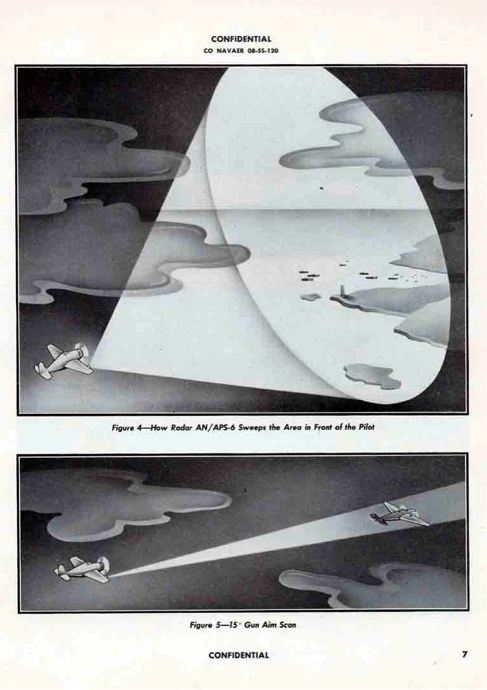
The two modes of the APS-6 Radar are shown in this confidential image. The antenna beam width in the spiral scan mode was a 120- degree cone and in the conical scan (aim and shoot) mode it was manually switched by the pilot into the narrow 15-degree cone. (U.S. Navy Pilot Operating Manual, Feb. 17, 1944)
The AN/APS-4 radar used on F6F aircraft had three distinct functions. The first was to search for enemy aircraft and surface vessels in darkness or fog. The search position had selectable ranges of sixty-five, twenty-five, five, and one miles. A second function was for aiming guns carried by the aircraft in order to fire on enemy aircraft when in proper position. The gun aim position switch was thrown when the target was within a half mile (one thousand yards). When in range of two-hundred fifty yards, the pilot was able to train his guns accurately on the target. The third function was as a beacon to locate carrier, land, or airborne beacon stations. In the beacon position the APS-4 would interact with the carrier, land, or airborne beacon stations, enabling aircraft to land safely aboard the carrier.
Test intercept missions flown by pilots under direction from Spraycliff resulted in simplifying APS-4 radar for single seat fighters into the AN/APS-6, also known as the AIA-1 airborne radar. It used a small two-inch diameter display as the gun sight. The APS-6, operated with only six knobs, still weighed 250 pounds. The display featured a double-target system that showed next to the true target a secondary shadow, which indicated the target’s altitude relative to the F6F.
Early radar systems, while providing azimuth and range on targets, had no provisions to determine the altitude of airborne targets. Dr. Ernest Pollard, one of the most noted RadLab scientists and radar developers, who frequently visited Spraycliff, undertook the development of a system identified as the AN/ CPS-4 height finder radar. He also had built an experimental model for testing and evaluation at Beavertail. The land-based radar at Spraycliff had a range of ninety miles, using a twenty-five foot high antenna operated in the S-Band (2-4 GHz). It was nicknamed the Beaver Tail. The CPS-4 was used by controllers at Spraycliff along with SCR 270-271 radar search sets to vector the night fighting aircraft flying from Quonset and Charlestown during intercept training flights. Its success made it possible for it to be placed into production for use by anti-aircraft batteries. The CPS-4 went on to be used by the Air Defense Command worldwide for many years after the war and was also used as a precision air traffic ground control approach radar.
Pollard, for his work on radar development, received the President’s Certificate of Merit from President Harry Truman. As a result of this award, his role at Spraycliff was revealed. The identities of most other scientists and others toiling away at Spraycliff during the war were never revealed.
Night fighter training was dangerous work. As indicated on a memorial erected at the former Charlestown airfield (after the war an air station and then a landing field), forty-nine pilots were killed there in training accidents from 1943 through 1945. Nonetheless, under the guidance of Commander William E.G. Taylor, the night fighter pilots developed into an elite corps of flyers.
In August of 2003, three surviving Hellcat pilots and one electronics officer of Project Affirm, members of Air Squadron VN (N) 76, planning a sixtieth-year reunion, were invited by the Jamestown Historical Society to visit Beavertail. The four men, part of a group of twelve pilots and an electronics specialist, with their modified aircraft, were sent to the Pacific war theatre and assigned to three aircraft carriers, the USS Yorktown (CV-10), USS Lexington (CV-16), and USS Hornet (CV-12). Not only did they train the F6F carrier pilots in the use of radar, they also participated in extensive combat operations.
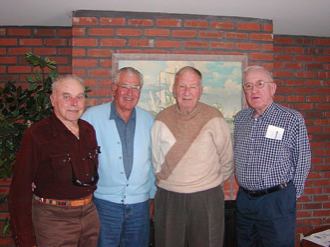
Project Affirm’s remaining cadre Air Squadron members: F6F pilots Fred Dungan, Paul Kepple, and John Gilman, and the electronics officer, Archie Stockebrand (Varoujan Karentz)
Here is a transcript of the interview of the four men, pilots Fred Dungan, Paul Kepple, and John Gilman, and electronics officer, Archie Stockebrand. (Listening to the transcript, it is not possible to identify who is speaking; I recall that most of the comments were made by Fred Dungan, with Archie Stockebrand chiming in from time to time. Dungan was credited with ten enemy aircraft shot down during the war.)
“Beavertail had a ground radar that directed us in the air to the bogey (the simulated enemy) and then we would come within sight, they would pull us into the back of the target and then we would say, ‘Tally Ho!’ and we would have the target in our radar scope and we would close in on him.”
“We had two little dots on the radar scope. The right hand dot would indicate whether the target was below us or above us so we could match his [the target’s] altitude and they would give us his speed, his estimated speed, and then we would add another fifty miles per hour to that and closing fast and then when we got to within a mile or two we’d slow down and match his speed and check the airspeed indicator to know exactly how fast we were going and then we’d close in [on the target] at ten or fifteen miles an hour faster.”
“During the last quarter of a mile, if the radar wouldn’t pick up the target you’d be in your cockpit looking for stars to be obliterated, for exhaust pipe glow to appear, for anything. And your imagination would start working. And I have seen huge big flying machines shaped like bats float over my cockpit. Oh, your imagination would just . . . dragons would float over and then finally you’d actually see something blocking out the stars. And if there were no stars you’d pick up the exhaust pipes, the little glow, and sneak up on this target, visually identify it, drop back one thousand feet and your night gun sight would indicate how far back you were.”
“You had to know the size of the airplane and then you would relate that on your radar scope and you’d touch your trigger and your six 50-calibers [guns] would fire at six hundred rounds per minute and that’s all it would take to eliminate that target.”
“Mickey fed us beautifully. These crazy flight directors were in this dark dark room watching the radar scope looking at blips on a chart and directing, and we had to try to direct too, and that was so difficult, trying to . . . a target is moving say about 180 knots, going in one direction, and you are trying to direct a fighter plane that is going about 180 knots in back of him and turn him to face so that his radar will pick up at within three miles, actually five miles. You would [eventually] pick up the target. Beyond five miles we couldn’t pick him up. But at three miles he’d be a very strong target.”
“It’s hard for me to visualize any serious formal training because in Project Affirm we all did it to the best of our ability, the only way you could, which was to follow the guy in front of you and to try to shoot him down, close in. But the training syllabus was established later and, what would it take, three months?”
“Well, we arrived in September of ’43, and took off for Hawaii in January of ‘44. So that was four months. And we left two months early, because they were getting nervous out there [the U.S. Navy command regarding the Pacific theatre]. They needed night fighters. The Japanese were destroying our efficiency by keeping the fleet awake at night. In November we lost Butch O’Hare on a night fighter strike team. The night fighter strike team at that time was made up of a torpedo plane that had big radar on it to close in on the target, and the fighter plane had the gun platform to shoot the target down. O’Hare got shot down by one of his own people. So they cancelled that program.” [Author’s note: on November 26, 1943, Butch O’Hare (for whom O’Hare Field in Chicago is named), flying an unmodified F6F-3 on a night mission with a TBF Avenger, disappeared over the Gilbert Islands.]
“They didn’t know what to do with us. Admiral Mitchell didn’t think the night fighters could fly at night or land at night. None of the skippers of the carriers had had any good experience at night. They’d all had night experience and lost people. Crashing into the island, crashing on landing, losing them by disappearing, engine malfunctions on takeoff.”
“The group I was with, the five pilots, ended up on the Yorktown [aircraft carrier]. The Yorktown was skippered by Jocko Clark, a full-blooded Cherokee Indian, the first Native American to graduate from Annapolis. He said to our skipper Russ Reiser, “I want you on the flight deck after supper to walk with me. I do my constitution then. I walk a couple of hours. His first comment to Russ Reiser was, “Welcome aboard Lieutenant Reiser. Now, just what the hell can you night fighters do that those day fighters can’t do?” He considered himself a day fighter. Well, Russ went on to tell him how we can sneak up behind them and shoot them down without them even seeing us and get back to carrier and land very nicely and have a nice sleep all night. Russ said Jocko Clarke’s face started to beam like he had found a new toy to play with – night fighters. Jocko Clarke wrote a book, an autobiography, entitled Carrier Admiral. In that book it was stated that Jocko Clarke turned the aircraft carrier from a defensive mechanism to an offensive mechanism. This was what he was thinking of: ‘How can I use this new tool I’ve got . . . oh goody goody goody . . . we can harass the Japs at night which we used to do. We used to go in at night and hit the islands and things. The first time we flew at night, it was about two weeks after we got aboard the carrier. All four went up and all four came back. We’d done it so often it was nothing. The day fighters wouldn’t even talk to us, they were so jealous; a little professional jealousy there. We were known as “Jocko’s boys,” those night fighters.”
“When we transferred to the Hornet [another aircraft carrier] and Jocko called for us, then it really became a little touchy in the Ready Room. We were with the day fighters and we didn’t play acey deucy with them. They couldn’t find anyone to talk to. We were ostracized. So then we found room in the torpedo squadron’s Ready Room and we went there. And they loved to have us there. It was great, really nice. A little jealousy there, you know, because we were so highly trained.”
“This was one thing Russ said, ‘Jocko, you must realize that we are trained at the peak of our profession, of our ability, like Olympic athletes. We have to fly a lot to maintain that proficiency.’ Jocko said, ‘I’ll see to that.’ That evening he got back to his cabin and he told the air group commander and said, ‘We’ve got these crazy night fighters aboard that have to fly a lot to maintain their proficiency.’ The commander [in turn] told the fighter skipper, ‘We’ve got these crazy guys who fly at night and they need a lot of practice during the daytime to maintain their night proficiency.’ And the day fighter skipper said, ‘I’ll use them on every strike I can use them except number one strike.’ Number one strike is usually when you have shot them down. Number two strike came into a clean field. But, it didn’t work that way. Number one strike would go into a target, he’d wake the enemy up. Number two strike, which we would be among, flying day fighters, would come in, shoot down some airplanes and come back. That’s why the five of us shot down twenty-seven aircraft. And this didn’t set very well with the day fighters either. We had the training flying up against the Japanese Zero. The Japanese Zero was a much better airplane than the Hellcat.”
“The interesting thing. We came back from a dog fight once and I went to the fighter Ready Room. We were all mixed up and we asked them if they saw this and this and this. I heard two of the old timers talking, one of ‘em said ‘You know that Zero, it’s the first time I’ve really seen it perform. But that Zero is some fine airplane. If we had been in Zeros and the people we shot down had been in Hellcats, we’d have still won, even more.’ Because they thought the Zero was that much of a better aircraft.”
“It was, under certain conditions . . . you kept those conditions in your favor when you were flying a Hellcat, which was slow. Keep it slow. At high speed we had such bulk and such weight that it would take us a long time to get that airplane maneuvered around. And every maneuver you make in an airplane is a parabolic maneuver. It has a start and an end and you can pretty well predict where that end is going to be unless something violent happens in the middle of a maneuver. At slow flight, the Hellcat, you can kick the rudder around and change direction, which the Japanese couldn’t do because their aircraft was that much more delicate. It wasn’t as beefy. It would tear the wings off of it, if they tried that. Plus we had the horsepower to pull us from a dead stall right up into a climb. That they didn’t have. So we had advantages that you could use for yourself and make the Japanese look a little sick, and [you could] come back. Because only one person comes back from the dog fight.”
“Johnny Deere was our gunner officer he was a good gunner. He said we will have all fifty calibers to meet at one spot at 1,000 feet. Now the day fighters we were flying with had the outboard guns meeting at 1,200 feet, the mid guns at 1,000 feet, and the inboard guns at 750 feet, which is like taking a handful of gravel and throwing it at a bird. Our guns all pinpointed at 1,000 feet and it was like taking a rock and throwing it at the bird. You hit him. He’s gone.”
Today, as seen in the Google satellite image above, little remains visible of the once top-secret Spraycliff Observatory facility. Its significant contribution to the victory in the Pacific theater is now but a memory.
Banner Image: Spraycliff Observatory in October 1945, in a rare photograph showing its World War II operations (Library, Bureau of Aeronautics)
Bibliography
Interviews:
Author Discussions and Communications with Paul V. Zecchino, June 2011
Author Discussions and Communications with James Osborne, June-July 2011
Author Discussions and Communications with Anna Templeton Cotill, August 2010 (she also provided photographs)
Interview with Pilots from Squadron VN (N) 76, August 2003, transcript by Deneb Karentz, Jamestown Historical Society
Unpublished Material:
Beavertail Deeds, Land Evidence Records, Town Clerk’s Office, Town Hall, Jamestown, Rhode Island
N51-209 File, MIT Museum
Photographs, Special Media Services Division, National Archives, College Park, Maryland.
Spraycliff Logs and Progress Reports, 1943, Copies, National Archives, Waltham, Massachusetts
Varoujan Karentz Collection, Jamestown Historical Society
Publications:
“Beavertail Unit Expansion,” Newport Daily News (May 18 1950)
Coletta, Paolo, United States Navy and Marine Corps Bases (Greenwood Press, 1985)
History of Grumman Aircraft’s Naval Fighter of WW II, F6F Hellcat (Grumman Aircraft Co., 1992)
Karentz, Varoujan, Beavertail Light Station (BookSurge Publishing, 2008)( particularly chapter 10)
Karentz, Varoujan, Harbor Entrance Command Post: The HECP at Fort Burnside, Beavertail Point, Conanicut Island, Jamestown, RI (Jamestown Historical Society, 2000)
McBurney, Christian, Brian L. Wallin, Patrick T. Conley, John W. Kennedy and Maureen A. Taylor, World War II Rhode Island (History Press, 2017)
MIT Radiation Laboratory Series, vol. 1 (1947-53), L. N. Ridenour, editor (McGraw-Hill) (technical manual)
“The MIT Radiation Laboratory: RLE’s Microwave Heritage, RLE Currents, Vol. 4, No. 2 (The Research Laboratory of Electronics at the Massachusetts Institute of Technology, Spring 1991)
Parish, Karl, “Mickey and the Night Fighters,” Naval History, vol. 17, Issue 6 (Dec. 2003)
Schroder, Walter K., Defenses of Narragansett Bay in World War II (Rhode Island Publications Society,1980)
Tillmam, Barrent, “King of the Pacific Fighters,” Pacific Fighters, Air Combat Stories (Air Age Publishing, 2003)
U.S. Army Corps of Engineers, Communications Site Investigation Report (April 22, 1994)
U.S. Army Corps of Engineers, Site Survey Report Fort Burnside (June 24, 1994)
Woodbury, David O., Battlefronts of Industry: Westinghouse in World War II (John Wiley & Sons, 1948)

